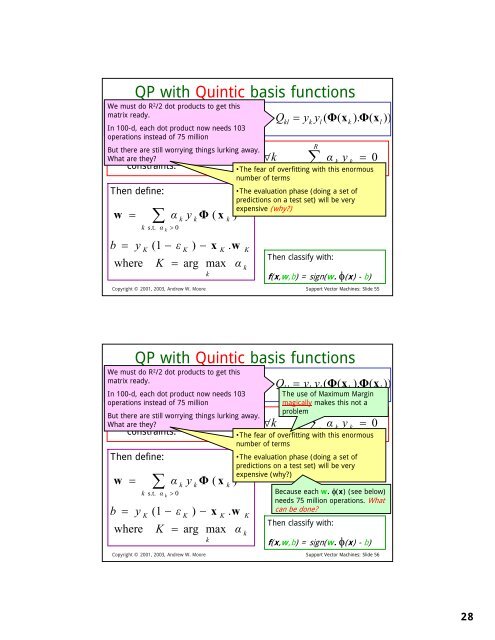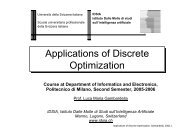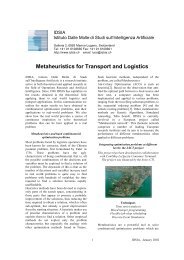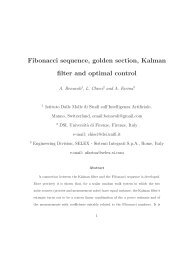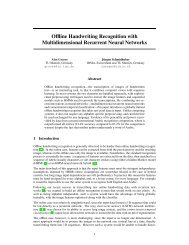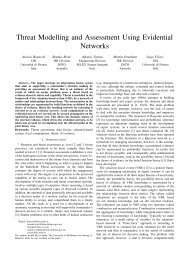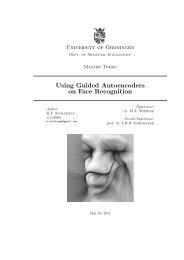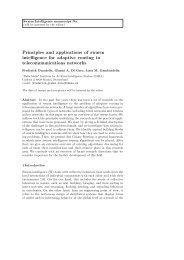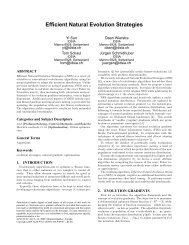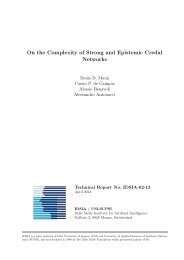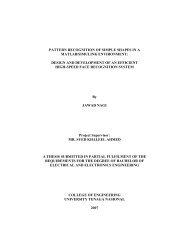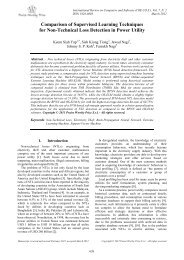Support Vector Machines - The Auton Lab
Support Vector Machines - The Auton Lab
Support Vector Machines - The Auton Lab
You also want an ePaper? Increase the reach of your titles
YUMPU automatically turns print PDFs into web optimized ePapers that Google loves.
Maximize<br />
QP with Quintic basis functions<br />
We must do R 2 /2 dot products R R to get this<br />
matrix ready.<br />
∑αk<br />
+ ∑∑αkαlQ<br />
where Q ( ( ). ( ))<br />
kl<br />
kl<br />
= yk<br />
yl<br />
Φ xk<br />
Φ xl<br />
In 100-d, each k = 1dot product k = 1now l=<br />
1 needs 103<br />
operations instead of 75 million<br />
R<br />
But there are still worrying things lurking away.<br />
Subject to these<br />
What are they? 0 ≤ α k<br />
≤ C ∀k<br />
∑ α k<br />
y k<br />
= 0<br />
constraints:<br />
•<strong>The</strong> fear of overfitting kwith = 1 this enormous<br />
number of terms<br />
<strong>The</strong>n define:<br />
•<strong>The</strong> evaluation phase (doing a set of<br />
predictions on a test set) will be very<br />
expensive (why?)<br />
w<br />
=<br />
k s.t.<br />
∑<br />
α k<br />
α<br />
y k k<br />
> 0<br />
Φ ( x<br />
b = y<br />
K<br />
(1 − ε<br />
K<br />
) − x<br />
K<br />
. w<br />
where K = arg max α<br />
k<br />
k<br />
)<br />
K<br />
k<br />
<strong>The</strong>n classify with:<br />
f(x,w,b) = sign(w. φ(x) -b)<br />
Copyright © 2001, 2003, Andrew W. Moore <strong>Support</strong> <strong>Vector</strong> <strong>Machines</strong>: Slide 55<br />
Maximize<br />
QP with Quintic basis functions<br />
We must do R 2 /2 dot products R R to get this<br />
matrix ready.<br />
∑αk<br />
+ ∑∑αkαlQ<br />
where Q ( ( ). ( ))<br />
kl<br />
kl<br />
= yk<br />
yl<br />
Φ xk<br />
Φ xl<br />
In 100-d, each k = 1dot product k = 1now l=<br />
1 needs 103<br />
<strong>The</strong> use of Maximum Margin<br />
operations instead of 75 million<br />
magically makes this not a<br />
problem R<br />
But there are still worrying things lurking away.<br />
Subject to these<br />
What are they? 0 ≤ α k<br />
≤ C ∀k<br />
∑ α k<br />
y k<br />
= 0<br />
constraints:<br />
•<strong>The</strong> fear of overfitting kwith = 1 this enormous<br />
number of terms<br />
<strong>The</strong>n define:<br />
•<strong>The</strong> evaluation phase (doing a set of<br />
predictions on a test set) will be very<br />
expensive (why?)<br />
w<br />
=<br />
k s.t.<br />
∑<br />
α k<br />
α<br />
y k k<br />
> 0<br />
Φ ( x<br />
b = y<br />
K<br />
(1 − ε<br />
K<br />
) − x<br />
K<br />
. w<br />
where K = arg max α<br />
k<br />
k<br />
)<br />
K<br />
k<br />
Because each w. φ(x) (see below)<br />
needs 75 million operations. What<br />
can be done?<br />
<strong>The</strong>n classify with:<br />
f(x,w,b) = sign(w. φ(x) -b)<br />
Copyright © 2001, 2003, Andrew W. Moore <strong>Support</strong> <strong>Vector</strong> <strong>Machines</strong>: Slide 56<br />
28


